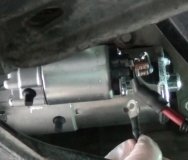Hi,
I hope you don't mind me jumping in. I wanted to note that there was a technical service bulletin on these vehicles when equipped with a Bosch starter motor. The wiring was coming loose. Check that isn't the issue before replacing the starter. Here is the TSB:
___________________________________
1993 Land Rover Range Rover County (LH) V8-3.9L
Starter - Engine No-Start Condition
Vehicle Starting and Charging Starting System Starter Motor Technical Service Bulletins Starter - Engine No-Start Condition
STARTER - ENGINE NO-START CONDITION
Loose Starter Cable Connection
AFFECTED VEHICLE RANGE:
Range Rover (LP) Bosch-Starter Equipped
SITUATION:
LOOSE ELECTRICAL CONNECTOR AT STARTER MOTOR
Vehicles equipped with a Bosch starter may experience non-start symptoms that suggest that the starter motor is not functioning correctly. These vehicles may fail to crank or intermittently may fail to crank.
The primary electrical connection between the starter and the battery may not be adequately tightened on vehicles exhibiting these symptoms. A low torque condition will not provide a solid electrical connection.
RESOLUTION:
TIGHTEN CABLE CONNECTION TO SPECIFICATION
Whenever a no-crank situation is encountered on Range Rover or Discovery vehicles equipped with a
Bosch starter, the first check should be to tighten the main starter electrical cable connection to the
specified torque.
PARTS INFORMATION:
Locally Sourced
Star lock washer Qty 1
WARRANTY CLAIMS:
NOTE:
The procedure in this TIB should always be performed before replacing a starter to eliminate the possibility that an improperly tightened solenoid nut is not the root cause of the no-crank problem.
86.60.89/27 Time 0.20 hrs. Install star type lock washer and tighten starter cable to specified torque
FAULT CODE: S
Normal warranty policy and procedures apply
REPAIR PROCEDURE
TIGHTEN STARTER SOLENOID NUT
NOTE:
Replacement of the starter motor is not indicated unless the electrical connection has been checked for proper torque as described below.
1. Disconnect battery ground terminal.
2. Slacken and remove the battery-lead-to-starter-solenoid securing nut at the starter solenoid.
3. Clean all connection surfaces.
4. Install a star washer on the solenoid stud.
Pic 1
5. Install and tighten the nut to 18 Nm (13 lbf. In.). (Figure 1)
6. Clean and install battery ground terminal.
7. Start vehicle to verify repair.
NOTE:
If vehicle fails to crank after the torque repair, replacement of the starter motor may be indicated following standard Workshop Manual and Warranty procedures provided:
Current supply to the starter terminal is normal (12 Vdc).
Other systems are functioning normally.
*NOTE:
New drive plate balance weights should be fitted whenever a starter motor is replaced on vehicles within the following VIN ranges:
Discovery Series II (LT) XA900012 to XA907212 XA200412 to 1A299999 1A700000 to 1A729921 Range Rover 4.0146 (LP) XA410483 to 1A459035
Always perform the procedures in TIB 86/08/01/NAS when the starter requires replacement. Inspect pinion and over-run clutch for evidence of contact or "machining" damage to components. If damage is evident, balance weight replacement is required to remove the source of the damage.
___________________
Hope this helps.
Joe
Image (Click to make bigger)
Wednesday, November 11th, 2020 AT 6:18 PM





